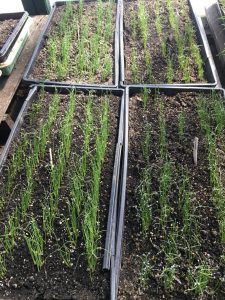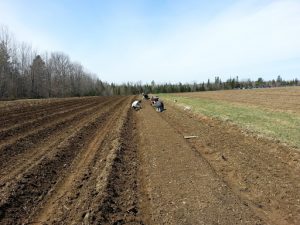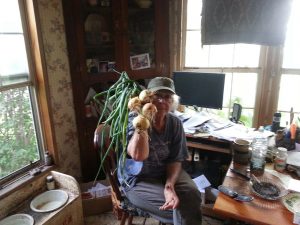On Onions
by Tom Roberts, February 2018

Onion seedlings are available from us at the farm, at our farmers’ markets, and in our online store.
Order the onion family seedlings (onions, leeks, shallots) for pickup between April 15 and May 20.
Starting Onion Seedlings.
We plant our onion flats not randomly, but by using five rows of seeds per flat. This makes removing a short piece of row—an inch or two—fairly easy. Then we separate each onion seedling to plant. We are always short of non-freezing sunny space early in the season, before we move into the greenhouses, so we try to pack as many onions as is practical and optimal into each flat.
We plant onions that thickly because we are taking advantage of the fact that onions at an early stage in life are very resistant to transplant shock. Not that they don’t all just limp over right after transplanting, but within a day they are back up and perky as ever. Transplanting of course means essentially bare-root transplanting, since a few inches of onions are removed from the tray and separated one-by-one as they are each stuck into holes poked in the freshly tilled ground. As long as all or most of the roots get buried, they will be fine. This assumes, of course, that the soil is fairly moist which it almost always is in early spring. As a rule, we want to be on the ground planting onions within two weeks of last snow melt.
Planting Onion Seedlings.
Basically the rule is: as soon as you can work the ground, it’s time to plant onions. Most years here in central Maine, this means around mid April. Since most onions are day-length sensitive, it is important to get them in the ground and growing as long as possible before the summer solstice, at which point their biology changes from growing a plant to growing a bulb. So, if your compost was spread and beds made last fall, you’re good to go as soon as you can poke a hole in the ground. If you didn’t have that foresight, then you’ve already lost a week or so in the spring as you spread and incorporate compost and make your beds. Anyway, you always want to plant by using your climate as a guide and not by using the calendar. Some years we are delayed three weeks by late lingering snows; we have done an early May planting, but what are you going to do when there is still snow on the ground until then?

If you have your onion plants but the season is really late, just keep their tops trimmed to 6″ and maybe fish feed then once or twice. Since onions are bare-root transplanted, we fish feed by soaking each tray in fish solution about a week prior to transplanting so that the plants have time to absorb the nutrients. Our plug transplanted veggies get the same treatment, but on the day of transplanting.
For the past twenty years we have planted onions singly (except scallions which we plant in clumps grown in 72’s). Before that we experimented with group-planting onions, which works kind of OK, except you are almost guaranteed to get a small onion or two in each cluster, and the larger ones might grow with a flat side as it grew against its neighbors. Since onions are heavy feeders, we have decided it is best to give each one its own elbow-room, aiming for plants 6″ apart in rows that are also 6″ apart. If you get a 3-4″ onion at each location, you can see that this actually turns out to be pretty closely planted.Our onions plants tend to be 5-6 inches tall when we transplant them. If they get longer than this, we’ll trim the tops with scissors to encourage root and stalk growth.
The ground.
Surviving sod is the bane of the onion patch. Onions are both poor competitors (they hardly cast a shadow!) and don’t do well with competition that shades them and steals their water and nutrients. Sod, on the other hand, even beat up sod, will re-grow and do quite well at re-establishing itself if left alone because it is amongst the onions. For fighting newly broken or recovering sod, I’ve found a cover crop spring-to-fall series of oats, buckwheat, buckwheat, and oats works very well. It’s best not to try any crop on such ground until the perennial weeds are all but gone.
In general you will be thankful for planting your onions in the most perennial-weed-free ground you have. Annual weeds will be taken care of by mulching soon after transplanting.
The mulch.
We mulch with shredded or rotted leaves because they can be inserted between fragile onion plants easier than most other mulches. There is a need to wait about a week after planting so that all the limped over onions are all standing tall again.The shredded leaf mulch does a good job of holding water in the soil during the dry season and suppressing weed seed germination. Note that mulches will not stop quack grass or grass sods from pushing up through the mulch; they will only delay these by a week or so.
We have been applying the shredded leaves about three inches thick, by the handful, from crates walked down the onion aisles to the current mulching location. In 2017, we tried the idea of using the manure spreader to spread the shredded leaves beforehand then planting through the already-applied mulch. This was a lot slower going (especially to get the onion roots in sure contact with the soil) but it also eliminated having to slowly place the mulch between the onion plants by hand later on. On balance, pre-mulching this way was a net time-saver. Where it didn’t work out well is where the spreader didn’t get the leaves spread evenly due to running out or due to windy conditions. Going back over these areas to mulch them should have fixed the problem, but we didn’t always get to that in a timely fashion.
The Growing Season.
Right after finishing the transplanting, you’ll look back at your onion bed and wonder if there was anything planted there at all—the tiny plants are the size of pencil leads. However, if you have planted them in good soil they will begin to double in size almost weekly.
During the season take the time to walk along the beds and pull out any weeds. Weeds pulled when small will disrupt the onion roots far less than that same weed pulled in a week or two.
You may note that some onions beginning to put up tall “onion dome” tops reminiscent of Moscow skyline architecture. These are duds which will not produce a good onion and should be pulled so they will stop wasting nutrients and soil moisture. This is a defect and is an indication of lower quality seed that was planted—consider changing your seed source next year. Do NOT collect any seeds that these may produce or you will be selecting for exactly the wrong onion genes.
The Harvest.

In late July look for a few onions that are beginning to produce nice bulbs. These can be harvested as “fresh onions”. [They are not “green onions”, a term which refers to the thinnings from seed-planted onion rows which look a lot like scallions, and, unlike scallions, are available only during a short season of the year about six weeks after being planted.] Fresh onions will not keep well since they are not mature, so plan on using what you harvest within the week.
The indication of maturity in an onion is when the previously stiff top becomes soft and weak just above the bulb. At this point the tops of some of the onions will begin to fall over, or “go down”. Note that since all onion varieties do not mature at the same time, onions in one bed may be going down while onions in a bed of another variety may show no indication of doing so. Later on, one variety may be almost entirely harvested while another variety is just beginning to go down. In our latitude the earliest of the onions (walla walla, white wing) are usually the first to show signs of going down. Shallots behave very similarly to onions.
Our onions begin to go down in mid to late August, and by mid September they are usually all harvested and being cured.
Pulling the whole patch when the first few onions go down is usually not a good idea, since those that have not gone down are not fully mature, and thus will not keep as well as those that have gone down. In an effort to hurry things up, sometimes folks will knock over all their onions once a good portion of the patch has gone down of its own accord. This forces the onions to stop their growth time and begin to prepare themselves for harvest and storage.
Pull those onions that have gone down, shake the soil from the roots, and lay them in groups on the ground for a day or two, allowing the tops to begin to die back. Doing this in extremely hot weather is risky, since the onions may actually cook in the field if the weather is sunny and in the 90’s. Watch the weather forecast for cool, sunny weather. This is the beginning of the curing process that transitions the onion from a growing bulb to a bulb ready for long or short term storage, depending on variety.
After the onions have dried for a day or two, cut off the tops at about 1 to 1½ inches above the bulb. A sharp knife works better than scissors. Do not cut too close to the bulb, or the top of the onion will not dry properly and will be prone to spoilage. Leave the roots alone at this point, as long as there isn’t any soil clinging to them. Spread out all the cut off onion tops so they will be easier to incorporate back into the soil.
After Harvest Care.
Now you presumably have several buckets of newly harvested onions without their tops, but they still have significant drying and curing to do. Although they may be eaten now at any time, those which are intended for maximum storage life (which varies by variety) need to be stored in a cool dry location where there is plenty of air circulation. Ideally, they can be laid out two layers deep out of both the direct sun and the weather for up to a month as they cure.
After curing they may be stored in any container that allows free air circulation. Used mesh onion bags are excellent. Store in a dry location of constant, preferably cool or cold temperature.
Onions may be classified as either sweet or pungent. The sweet onions are the ones you’d want on a burger or in a salad, due to their mild flavor. Pungent ones are those that make you cry when you cut into them and are generally used for cooking. What makes an onion pungent are the sulfur compounds it contains; pungent onions have a higher sulfur content and sweet onions a lower sulfur content. Sulfur compounds are also what allows an onion to keep longer, so all the pungent onions have all the sweet onions beat when it comes to storage life.
Here’s a chart of the potential storage life of the various onion varieties we grow, from an August/September harvest, based on our experience. This assumes nearly ideal storage conditions and that a certain percentage of each variety will not make it that long. Remember: whenever you see an onion starting to sprout, that’s the one to have for dinner. Let the keepers keep keeping.
| Variety | Cortland | Patterson | Redwing | Ailsa Craig | Walla Walla | White Wing | Shallots |
| Keeps until | June | March | June | November | Late October | Mid October | June |
You can find seedling paks of these onion varieties at the farmers’ markets we attend or at the farm, and you can order our onions seedling ahead at our online store.
